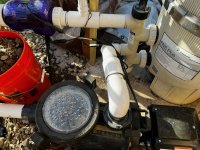Rod,
I forgot that you had a check valve on the pressure side of your waterfall pump. That check valve is there to prevent the water in the waterfall from draining back into the pool. This means that your waterfall pump should stay full of water when the pump is off. I feel better now..

Did all the knocking and vibrating go away? Not sure if that happened with your pool pump or waterfall pump.

As far as priming goes, in-ground pool pumps create a suction that pulls the water out of the pool. When a pump will not prime it is normally due to an air leak. It is easier for the pump to suck air than it is to suck water. The first place to look is the pump lid O-Ring. But if a pump has run with no place for the water to go, like a dead-headed valve, or a bad check valve on the pressure side, the impeller will churn the water and cause it to get hot. It can get so hot that it will deform the pump basket and not allow the lid to seal.
Thanks,
Jim R.










